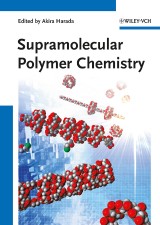Details
Supramolecular Polymer Chemistry
1. Aufl.
|
160,99 € |
|
| Verlag: | Wiley-VCH (D) |
| Format: | |
| Veröffentl.: | 08.12.2011 |
| ISBN/EAN: | 9783527639809 |
| Sprache: | englisch |
| Anzahl Seiten: | 390 |
DRM-geschütztes eBook, Sie benötigen z.B. Adobe Digital Editions und eine Adobe ID zum Lesen.
Beschreibungen
Presenting the work of pioneering experts in this exciting field of supramolecular polymer chemistry, this monograph covers an extensive range of applications, including drug delivery and catalysis. It focuses on new structures and phenomena of cyclodextrin-based supramolecular polymers and many other compound classes. While providing a deeper insight in macromolecular recognition and the mechanisms of living systems, this book also introduces fascinating novel phenomena beyond natural systems.
Preface<br> <br> PART I: Formation of Supramolecular Polymers<br> <br> MULTIPLE HYDROGEN-BONDED SUPRAMOLECULAR POLYMERS<br> Introduction<br> General Concepts of Hydrogen-Bonding Motifs<br> Hydrogen-Bonded Main-Chain Supramolecular Polymers<br> From Supramolecular Polymers to Supramolecular Materials<br> Future Perspectives<br> <br> CYCLODEXTRIN-BASED SUPRAMOLECULAR POLYMERS<br> Introduction<br> Supramolecular Polymers in the Solid State<br> Formation of Homo-Intramolecular and Intermolecular Complexes by CDs-Guest Conjugates<br> Formation of Intermolecular Complexes by CD and Guest Dimers<br> Artificial Molecular Muscle Based on c2-Daisy Chain<br> Conclusion and Outlook<br> <br> SUPRA-MACROMOLECULAR CHEMISTRY: TOWARD DESIGN OF NEW ORGANIC MATERIALS FROM SUPRAMOLECULAR STANDPOINTS<br> Introduction<br> Small Molecules, Macromolecules, and Supramolecules: Design of their Composite Materials<br> Conclusion and Outlook<br> <br> POLYMERIZATION WITH DITOPIC CAVITAND MONOMERS<br> Introduction<br> Cavitands<br> Self-Assembly of Ditopic Cavitand Monomers<br> Conclusions and Outlook<br> <br> PART II: Supramolecular Polymers with Unique Structures<br> <br> POLYMERS CONTAINING COVALENTLY BONDED AND SUPRAMOLECULARLY ATTACHED CYCLODEXTRINS AS SIDE GROUPS<br> Polymers with Covalently Bonded Cyclodextrins as Side Groups<br> Side Chain Polyrotaxanes and Polypseudorotaxanes<br> <br> ANTIBODY DENDRIMERS AND DNA CATENANES<br> Molecular Recognition in Biological Systems<br> Antibody Supramolecules<br> DNA Supramolecules<br> Conclusions<br> <br> CROWN ETHER-BASED POLYMERIC ROTAXANES<br> Introduction<br> Daisy Chains<br> Supramolecular Polymers<br> Dendritic Rotaxanes<br> Dendronized Polymers<br> Main Chain Rotaxanes Based on Polymeric Crowns (Including Crosslinked Systems)<br> Side Chain Rotaxanes Based on Pendent Crowns<br> Poly[2]rotaxanes<br> Poly[3]rotaxanes<br> Polymeric End Group Pseudorotaxanes<br> Chain Extension and Block Copolymers from End Groups<br> Star Polymers from Crown Functionalized Polymers<br> <br> PART III: Properties and Functions<br> <br> PROCESSIVE ROTAXANE CATALYSTS<br> Introduction<br> Results and Discussion<br> Conclusion<br> <br> EMERGING BIOMEDICAL FUNCTIONS THROUGH 'MOBILE' POLYROTAXANES<br> Introduction<br> Multivalent Interaction using Ligand-Conjugated Polyrotaxanes<br> The Formation of Polyrotaxane Loops as a Dynamic Interface<br> Cytocleavable Polyrotaxanes for Gene Delivery<br> Conclusion<br> Appendix<br> <br> SLIDE-RING MATERIALS USING POLYROTAXANE<br> Introduction<br> Pulley Effect of Slide-Ring Materials<br> Synthesis of Slide-Ring Materials<br> Scattering Studies of Slide-Ring Gels<br> Mechanical Properties of Slide-Ring Gels<br> Sliding Graft Copolymers<br> Recent Trends of Slide-Ring Materials<br> Concluding Remarks<br> <br> STIMULI-RESPONSIVE SYSTEMS<br> Introduction<br> Stimuli and Responses<br> Examples of Stimuli-Responsive Supramolecular Polymer Systems<br> Concluding Remarks<br> <br> PHYSICAL ORGANIC CHEMISTRY OF SUPRAMOLECULAR POLYMERS<br> Introduction and Background<br> Linear Supramolecular Polymers<br> Cross-Linked SPs Networks<br> Hybrid Polymer Gels<br> Conclusion<br> <br> TOPOLOGICAL POLYMER CHEMISTRY: A QUEST FOR STRANGE POLYMER RINGS<br> Introduction<br> Systematic Classification of Nonlinear Polymer Topologies<br> Topological Isomerism<br> Designing Unusual Polymer Rings by Electrostatic Self-Assembly and Covalent Fixation<br> Conclusion and Future Perspectives<br> <br> STRUCTURE AND DYNAMIC BEHAVIOR OF ORGANOMETALLIC ROTAXANES<br> Introduction<br> Conclusion <br> Appendix: Experimental Section<br> <br> POLYROTAXANE NETWORKS AS A TOPOLOGICALLY CROSS-LINKED POLYMER: SYNTHESIS AND PROPERTIES<br> Introduction<br> Linking of Wheels of Main-Chain-Type Polyrotaxane -<br> Structurally Defined Polyrotaxane Network<br> Linking of Macrocyclic Units of Polymacrocycle with Axle Unit to Directly Yield a Polyrotaxane Network<br> Linking of Wheels of Polyrotaxane Cross-Linker to Afford Polyrotaxane Network: Design of the Cross-Linker<br> Conclusion<br> <br> FROM CHEMICAL TOPOLOGY TO MOLECULAR MACHINES<br> Introduction<br> Copper(I)-Templated Synthesis of Catenanes: The 'Entwining' Approach and the 'Gathering and Threading' Strategy<br> Molecular Knots<br> Molecular Machines Based on Catenanes and Rotaxanes<br> Two-Dimensional Interlocking Arrays<br> A [3]rotaxane Acting as an Adjustable Receptor: Toward a Molecular 'Press'<br> Conclusion
Akira Harada is a professor at the Graduate School of Science, Osaka University, Japan, where he gained his PhD in 1977. He began his career as a visiting scientist at IBM research in San Jose, followed by a postdoctoral fellowship at Colorado State University. He returned to Osaka University as an assistant professor in 1982, spent a year as a visiting scientist at The Scripps Institute in 1991, and became a full professor in 1998. He is the recipient of several awards, including the IBM Science Award, Osaka Science Award, Japan Polymer Society Award, Cyclodextrin Society Award, Izatt-Christensen International Award, and the Medal with Purple Ribbon from the Japanese Government. Professor Harada is a member of the Chemical Society of Japan, Polymer Society of Japan, the American Chemical Society, and the Society of Biochemistry, and is on the board of four scientific journals. His research interests cover supramolecular chemistry, polymer synthesis and assembly of bio-related polymers.
Supramolecular chemistry deals with some of the hottest current scientific advances within the field and polymer chemistry is now a multi-billion euro industry. Thus, enabling novel advances in polymer chemistry by taking innovative ideas from supramolecular chemistry is thus of profound interest. <br> Presenting the work of pioneering experts in the resulting exciting field of supramolecular polymer chemistry, this monograph covers an<br> extensive range of applications, including drug delivery and catalysis. It focuses on new structures and phenomena of cyclodextrin-based<br> supramolecular polymers and many other compound classes. <br> The contents are clearly divided into three parts that deal in turn with the formation of supramolecular polymers, supramolecular polymers with unique structures, and, lastly, their properties and functions. <br> While providing a deeper insight in macromolecular recognition and the mechanisms of living systems, this book also introduces breathtaking<br> new phenomena beyond natural systems, making it fascinating reading for organic, polymer, catalytic, medicinal and biochemists, as well as for materials scientists.


















